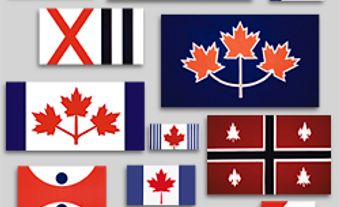
Heraldry
Heraldry is the creation or study of armorial bearings. Signs and symbols both convey messages, and symbols also play on our emotions. An arrow showing direction elicits no emotional response, but grasping the symbolic value of a flag requires emotional involvement: pride, devotion, patriotism or admiration. An emblem is a sign with a conventionally accepted meaning. The parliamentary mace had its probable origin as an instrument of physical discipline in assemblies, but today it is accepted by convention as an emblem of authority, and as a symbol it arouses respect in viewers. Symbols are found in religion, in the arts and in customs. Coats of arms are visual symbols which reflect the beliefs, aspirations and history of individuals or of groups.
During the Crusades (11th-13th centuries), the European nations felt the need to identify themselves with crosses of various colours, and at the same time to reduce casualties with improved armour. The knight, whose head was entirely covered by a helmet, adopted for recognition a personal symbol which he displayed on his surcoat, shield and banner. Such symbols became the main components of a coat of arms (of which a crest is only a part). Coats of arms, or arms, have survived because they became hereditary within families and their use was extended to corporate and civic entities.
In 1407 a college of arms was created in France by Charles VI, and the granting of arms continued until 1790. The first known heraldic instance in Canada occurred 24 July 1534, when Jacques Cartier planted at Gaspé a large cross bearing the royal arms of France. The royal arms, 3 gold fleurs-de-lis on a blue field, continued to represent the king of France in the New World. One did not have to be of nobility to bear arms, but in practice most of the armigers (bearers of arms) in New France - government officials, military officers, clergymen and merchants - were nobles. A number of men received letters of nobility and subsequently grants of arms for their services to the sovereign, eg, Charles Le Moyne de Longueuil (1668), Nicolas Juchereau de Saint-Denis (published posthumously, 1697) and Joseph-François Hertel de la Fresnière (1716).
With the fall of New France, the officers of the British sovereign, the College of Arms in England and the Court of the Lord Lyon in Scotland became the granting authorities in Canada. Few Canadians of French origin have had recourse to British institutions to have their arms legitimized or to have new ones granted. One early exception, Gaspard-Joseph Chaussegros de Léry, recorded his father's arms and cross of Saint Louis at the College of Arms in June 1763. The first known grant to a Canadian after 1763 was made to James Cuthbert in 1778. The next known grant was to William McGillivray in 1801. Early grants were not numerous, in part because Canadians were busy building a country and had little time or money for the niceties of life. A number of cities and institutions took an interest in heraldry, but few had their arms officially recorded. This gave rise to a rather naive style of heraldry, with representations of steamboats, locomotives, grain elevators, factories and forests.
Today there is a revival of heraldry, probably because people are seeking special expressions of their own identities, but also because the importance of symbolism has been recognized in art, religion, psychology and the social sciences. The Heraldry Society of Canada has done much to foster a knowledge of heraldry and to induce cities, corporations, institutions and individuals to obtain grants of arms. Canadians who have become armigers include Governor General Georges P. Vanier, Lord Beaverbrook (see Max Aitken) and Lieutenant-Governor George F.G. Stanley. The number of municipalities with grants has considerably increased, and now includes Fredericton, Hamilton-Wentworth, Peace River (Alta), Esquimalt (BC) and Grand Falls-Windsor (Nfld). Among the many corporate or civic bodies bearing arms are the Royal Society of Canada, the Hudson's Bay Company, the Grey Nuns and numerous universities. Bishops and dioceses usually have arms, as do some counties.
A description in heraldic language is a blazon; the pictorial rendering is the emblazonment. Forms are stylized to bring out the salient points; proportions and the tonality of the colours are important. A good heraldic artist strives for individual style and avoids stereotypes. Without a Canadian heraldic authority, Canadians have been confused in heraldic matters, and designs on the whole have been poor. Canadians should be wary of anyone trying to sell them arms. The arms could be the property of an entirely different family branch with the same name. In most European countries and in Canada, arms are granted to an individual and his descendants; not every family has a coat of arms.
The National Archives of Canada (formerly Public Archives of Canada) responds to inquiries and, within reasonable limits, offers guidance to researchers or designers. It co-operates with museums and individuals to identify coats of arms on artifacts. With the help of heraldic artist and scholar Hans D. Birk, the arms of families from countries other than France and Britain now living in Canada are being documented and painted in colour. The main threat to heraldry today appears to be the logo, although heraldists warn that logos may be a passing form which, unlike heraldry, will not endure the test of time.

 Share on Facebook
Share on Facebook Share on X
Share on X Share by Email
Share by Email Share on Google Classroom
Share on Google Classroom



